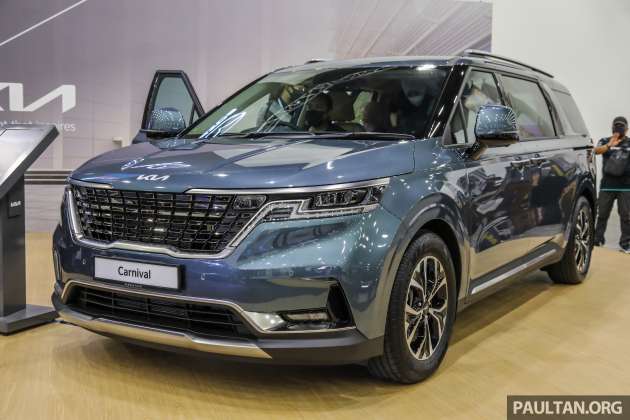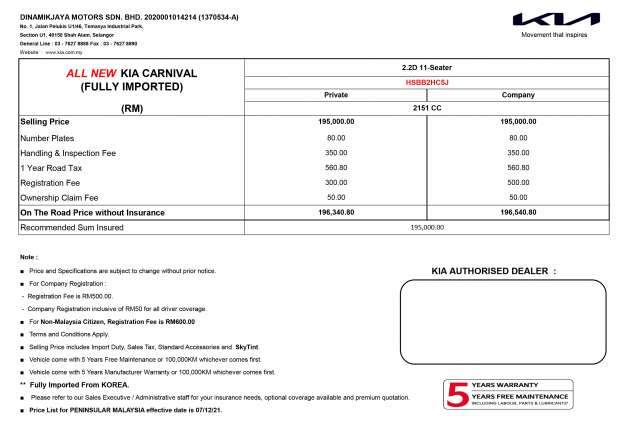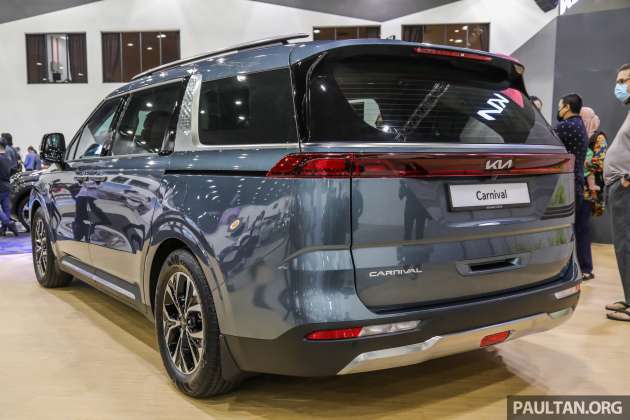Bermaz has finally confirmed pricing and announced the start of sales of the new Kia Carnival. The 11-seater MPV has had a long gestation to market, with numerous reports of its arrival followed by the spec sheet, a preview event and a pricing leak – but this is the real deal.
As previously reported, the new Carnival is priced at RM196,341 on-the-road, inclusive of the government’s 50% sales and service tax (SST) rebate for fully-imported (CBU) vehicles and a five-year/100,000 km warranty. The car comes all the way from South Korea, with CKD local assembly reportedly starting in April.
For the money, you get a 2.2 litre four-cylinder turbodiesel, rechristened the Smartstream D2.2 and equipped with a cast iron block instead of an aluminium one. Outputs are rated at 202 PS at 3,800 rpm and 441 Nm of torque from 1,750 to 2,750 rpm. It’s mated to an eight-speed automatic gearbox with paddle shifters.
On the outside, the Carnival has been given a comprehensive makeover, sporting a more sophisticated design and a few SUV-style elements such as black body cladding, silver front and rear skid plates and roof rails. At the front, you’ll find a large “tiger nose” grille that ties in the quad LED projector headlights and distinctive LED daytime running lights into a single graphic.
The clean side profile features a single shoulder line carrying the bonnet shutline, the door handles and the sliding door rail, plus blacked-out A- and D-pillars that give the car a trendy “floating roof” look. A chrome C-pillar fin, which features a subtle diamond pattern, provides some visual drama, while the rear end incorporates full-width bulb taillights to emphasise the car’s stance.
The Malaysian-market model is fitted with the latest Kia logo introduced this year, which can be found on the bonnet, tailgate, wheel centre caps and steering wheel airbag boss. The car also comes standard with 18-inch Y-spoke two-tone alloy wheels.
Inside, the Carnival is as much of a step-change over its predecessor as the outside, with a horizontal dashboard design, a tall centre console (incorporating a Jaguar-like rotary gear selector) and a freestanding display panel. The latter houses the 12.3-inch infotainment touchscreen with Apple CarPlay and Android Auto connectivity, as well as an analogue instrument cluster with a 4.2-inch multi-info display.
Cabin space has been improved thanks to the larger body. The Carnival is 40 mm longer at 5,155 mm, with 30 mm going towards the 3,090 mm wheelbase. The rear overhang has also grown by 30 mm to 1,130 mm, increasing third- and fourth-row space and luggage capacity. Width, meanwhile, is up 10 mm to 1,995 mm.
The 11 seats are spread out over four rows, with the second, third and fourth rows each equipped with three-abreast seating for a 2-3-3-3 configuration. The tiny second- and third-row centre seats are meant for temporary use, as they still only come with lap belts; they can be folded and tipped up to the side to allow for a central walk-through. Unfortunately for those of you with more than two kids, ISOFIX child seat anchors can only be found on the two outer second-row seats.
It goes without saying that the outer second- and third-row seats can slide and recline; they can also be folded and removed for a van-like cargo hold. Moving further rearward, the fourth row is a pop-up bench that can be folded in a single piece to provide some luggage space. Do bear in mind that with all seats up, the boot is practically unusable as the rearmost pews are right up against the tailgate.
In terms of cooling, the Carnival comes with dual-zone automatic climate control for the front occupants and single-zone controls for the second row (in the ceiling on the driver’s side), plus four rear air vents in the roof (two for the second row, two for the third and fourth rows). The vents themselves are of a circular design and are shared with the “van-like” Hyundai Staria. There are also manually-retractable sun shades on the four rearmost side windows.
The Carnival also comes with no less than 12 of cupholders, including two on the centre console, plus another two behind the front armrest. The temporary seats on the second and third rows also come with their own built-in cupholders that can be used when the seats are folded. Coupled with the four placed on top of the rear wheel arches, that means that the third row has a total of six cupholders!
You won’t be short on power sockets either, as the Carnival comes with two 12-volt sockets (one at the front, another beside the fourth row) and seven USB ports. The latter include three at the front in the large centre cubby hole, one on each of the front seats and one on either side of the third row.
Standard equipment includes front and rear fog lights, keyless entry, push-button start, eight-way power-adjustable front seats, Saddle Brown faux leather upholstery, a Qi wireless charger, six speakers, a 360-degree camera system and a hands-free powered sliding doors and tailgate.



Safety-wise, the Carnival comes with blind spot monitoring and rear cross traffic alert to go with seven airbags (one for the driver’s knee) and stability control. Unfortunately, however, the car does not get driver assistance features of any kind, including autonomous emergency braking. Hopefully the CKD model will address this.
Under the skin, the Grand Carnival comes with a revamped fully-independent suspension system and reduced noise, vibration and harshness, making for a more relaxed and comfortable drive. To that end, the front of the car features a multi-skeletal cross-member and new geometry to increase stability.
The rear, on the other hand, gets hydro bushings, longer and lower suspension arms, a revised spring layout and an adjusted damper angle to improve ride comfort. The more rigid bodyshell and increased sound insulation further improve refinement. Lastly, the column-mounted electric power steering increases response and quickens the steering ratio by 5.6%.
Source: Read Full Article







